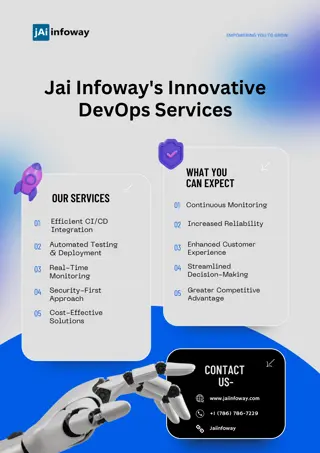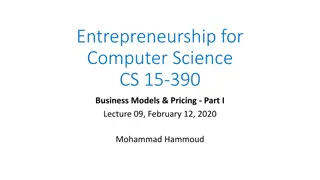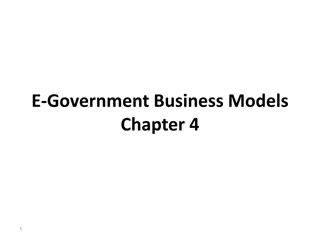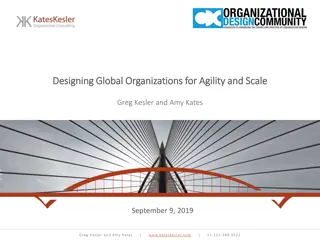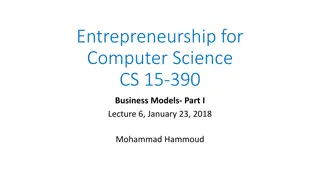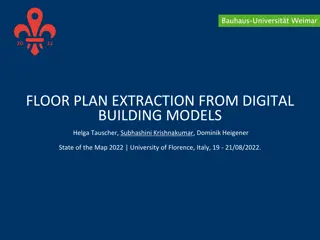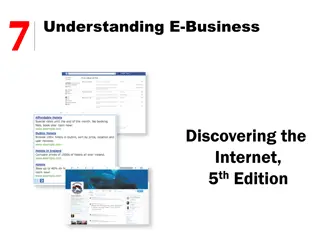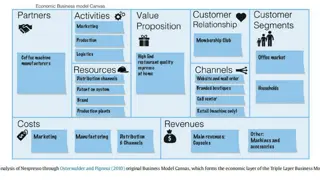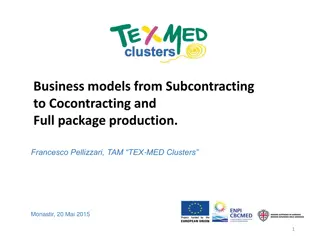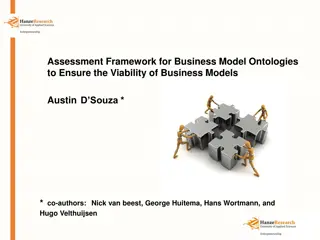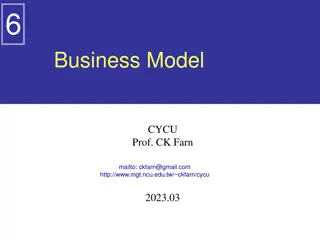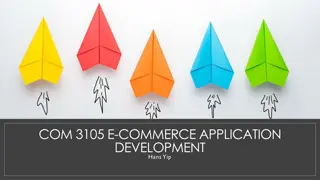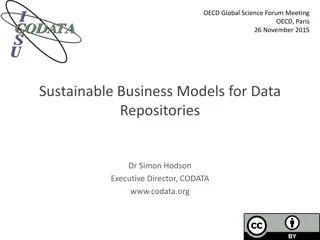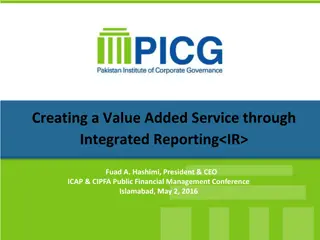Business Modelling and Innovation for Holistic Understanding and Growth
Explore the CGC Aarhus University International Summer Internship Program in Denmark focusing on business modelling and innovation. The program offers a comprehensive learning experience for graduate and postgraduate students, including online sessions and weeks in Denmark. Discover the significance
4 views • 14 slides
Overview of U.S. General Services Administration's Office of Small and Disadvantaged Business Utilization (OSDBU)
This overview discusses the role of the Office of Small and Disadvantaged Business Utilization (OSDBU) within the U.S. General Services Administration (GSA). It highlights the advocacy for small businesses in federal acquisitions, inclusion of small businesses as contractors, and management of small
3 views • 51 slides
Global Climate Models
Scientists simulate the climate system and project future scenarios by observing, measuring, and applying knowledge to computer models. These models represent Earth's surface and atmosphere using mathematical equations, which are converted to computer code. Supercomputers solve these equations to pr
3 views • 15 slides
System Models in Software Engineering: A Comprehensive Overview
System models play a crucial role in software engineering, aiding in understanding system functionality and communicating with customers. They include context models, behavioural models, data models, object models, and more, each offering unique perspectives on the system. Different types of system
3 views • 33 slides
Understanding Input-Output Models in Economics
Input-Output models, pioneered by Wassily Leontief, depict inter-industry relationships within an economy. These models analyze the dependencies between different sectors and have been utilized for studying agricultural production distribution, economic development planning, and impact analysis of i
8 views • 7 slides
E-Business
E-Business, or electronic business, encompasses computer-mediated processes in organizations, including for-profit, governmental, or nonprofit entities. It involves a range of business activities conducted over networks, focusing on production, customer service, and internal management processes. E-
0 views • 25 slides
Jai Infoway's Innovative DevOps Services
Transform Your Business with Jaiinfoway\u2019s Innovative DevOps Solutions\n\nElevate your business with Jaiinfoway\u2019s cutting-edge DevOps services. Experience rapid deployment, enhanced security, and continuous monitoring for seamless operations. Our automated testing and deployment processes e
1 views • 1 slides
Understanding Models of Teaching in Education
Exploring different models of teaching, such as Carroll's model, Proctor's model, and others, that guide educational activities and environments. These models specify learning outcomes, environmental conditions, performance criteria, and more to shape effective teaching practices. Functions of teach
2 views • 20 slides
Understanding Business Models and Pricing Strategies in Entrepreneurship
Explore the concept of business models and pricing in entrepreneurship, focusing on value creation versus value capture, different types of business models, such as the up-front charge model and transaction fee model. Learn how to monetize products or services based on the value provided to customer
0 views • 18 slides
Understanding Models of Teaching for Effective Learning
Models of teaching serve as instructional designs to facilitate students in acquiring knowledge, skills, and values by creating specific learning environments. Bruce Joyce and Marsha Weil classified teaching models into four families: Information Processing Models, Personal Models, Social Interactio
1 views • 28 slides
Significance of Models in Agricultural Geography
Models play a crucial role in various disciplines, including agricultural geography, by offering a simplified and hypothetical representation of complex phenomena. When used correctly, models help in understanding reality and empirical investigations, but misuse can lead to dangerous outcomes. Longm
0 views • 8 slides
Understanding CGE and DSGE Models: A Comparative Analysis
Explore the similarities between Computable General Equilibrium (CGE) models and Dynamic Stochastic General Equilibrium (DSGE) models, their equilibrium concepts, and the use of descriptive equilibria in empirical modeling. Learn how CGE and DSGE models simulate the operation of commodity and factor
4 views • 15 slides
Understanding E-Government Business Models for Enhanced Service Delivery
E-Government business models play a crucial role in enhancing service delivery in the public sector by simplifying complex operations and strategically adapting to changing market conditions. This concept supports organizations in analyzing success factors, developing new ideas, and creating superio
0 views • 69 slides
Enhancing Information Retrieval with Augmented Generation Models
Augmented generation models, such as REALM and RAG, integrate retrieval and generation tasks to improve information retrieval processes. These models leverage background knowledge and language models to enhance recall and candidate generation. REALM focuses on concatenation and retrieval operations,
1 views • 9 slides
Understanding Item Response Theory in Measurement Models
Item Response Theory (IRT) is a statistical measurement model used to describe the relationship between responses on a given item and the underlying trait being measured. It allows for indirectly measuring unobservable variables using indicators and provides advantages such as independent ability es
2 views • 32 slides
Evolving Global Organizations for Agility and Scale
Explore the evolution of global organizations in the face of globalization, digital disruption, and shifting business models. Learn about designing structures for agility and scale, integrating global and local models, and navigating the complexities of the modern business landscape. The future lies
0 views • 27 slides
Exploring Business Models in Entrepreneurship for Computer Science
Today's lecture covered the fundamentals of business models in entrepreneurship, emphasizing the importance of value creation and value capture. It discussed various types of business models, including the Up-Front Charge Model and the Transaction Fee Model, highlighting their respective features an
0 views • 18 slides
Understanding Discrete Optimization in Mathematical Modeling
Discrete Optimization is a field of applied mathematics that uses techniques from combinatorics, graph theory, linear programming, and algorithms to solve optimization problems over discrete structures. This involves creating mathematical models, defining objective functions, decision variables, and
0 views • 12 slides
Enhancing Private Sector Engagement in GEF Projects Towards Sustainable Development
Expanding private sector engagement in GEF projects is crucial for leveraging funding, expertise, innovation, and technology transfer. Through partnerships with various private sector actors, GEF aims to address environmental challenges effectively and promote sustainable business models. Reflection
2 views • 13 slides
Observational Constraints on Viable f(R) Gravity Models Analysis
Investigating f(R) gravity models by extending the Einstein-Hilbert action with an arbitrary function f(R). Conditions for viable models include positive gravitational constants, stable cosmological perturbations, asymptotic behavior towards the ΛCDM model, stability of late-time de Sitter point, a
1 views • 12 slides
Understanding Wireless Propagation Models: Challenges and Applications
Wireless propagation models play a crucial role in characterizing the wireless channel and understanding how signals are affected by environmental conditions. This article explores the different propagation mechanisms like reflection, diffraction, and scattering, along with the challenges and applic
1 views • 14 slides
Floor Plan Extraction from Digital Building Models: State of the Map 2022
Explore the innovative project LevelOut extracting indoor data from digital building models in IFC format to produce 2.5D floor plans. Discover the necessity of indoor mapping for gaining profound insights, enhancing navigation services, and enriching city models. Learn about the target formats incl
0 views • 7 slides
Models for On-line Control of Polymerization Processes: A Thesis Presentation
This presentation delves into developing models for on-line control of polymerization processes, focusing on reactors for similar systems. The work aims to extend existing knowledge on semi-batch emulsion copolymerization models, with a goal of formulating models for tubular reactors. Strategies, ba
0 views • 16 slides
Understanding N-Gram Models in Language Modelling
N-gram models play a crucial role in language modelling by predicting the next word in a sequence based on the probability of previous words. This technology is used in various applications such as word prediction, speech recognition, and spelling correction. By analyzing history and probabilities,
0 views • 101 slides
Understanding Information Retrieval Models and Processes
Delve into the world of information retrieval models with a focus on traditional approaches, main processes like indexing and retrieval, cases of one-term and multi-term queries, and the evolution of IR models from boolean to probabilistic and vector space models. Explore the concept of IR models, r
0 views • 65 slides
Understanding E-Business: Origins, Factors, and Models
The content delves into the origins of e-business transactions, highlighting Electronic Funds Transfer (EFT), Electronic Data Interchange (EDI), and Value-Added Networks (VANs). It also explores unique e-business factors like disintermediation and reintermediation in various industries. Additionally
0 views • 22 slides
Understanding Cross-Classified Models in Multilevel Modelling
Cross-classified models in multilevel modelling involve non-hierarchical data structures where entities are classified within multiple categories. These models extend traditional nested multilevel models by accounting for complex relationships among data levels. Professor William Browne from the Uni
0 views • 13 slides
Understanding General Equilibrium Models and Social Accounting Matrices
General Equilibrium Models (CGE) and Social Accounting Matrices (SAM) provide a comprehensive framework for analyzing economies and policies. This analysis delves into how CGE models help simulate various economic scenarios and their link to SAM, which serves as a key data input for the models. The
0 views • 50 slides
Sustainable Business Model Design with Triple-Layered Canvas
Explore the Triple Layered Business Model Canvas as a tool for designing sustainable business models, presented at the ARTEM Organizational Creativity International Conference in 2015. The innovative approach offers a structured way to enhance sustainability in business planning and development.
0 views • 4 slides
Evolution of Business Models from Subcontracting to Cocontracting and Full Package Production
The evolution of business models from subcontracting to cocontracting and full package production is discussed in this presentation by Francesco Pellizzari. It explores the origin of product specifications, functions in the business value chain, identification of business models, and evolution patte
0 views • 12 slides
Understanding Retrieval Models in Information Retrieval
Retrieval models play a crucial role in defining the search process, with various assumptions and ranking algorithms. Relevance, a complex concept, is central to these models, though subject to disagreement. An overview of different retrieval models like Boolean, Vector Space, and Probabilistic Mode
0 views • 56 slides
Understanding the Dynamics of Building a Successful Business in Nigeria
Starting a successful business in Nigeria requires careful planning, from ideation to business registration. This process involves developing a solid business idea, creating a detailed business plan, and registering the business with the Corporate Affairs Commission. By navigating the unique challen
0 views • 32 slides
Workshop on Business Model Canvas for IT Architects
Explore the use of business modeling in an organization context with a workshop focusing on modeling your business using the Business Model Canvas. Understand your business model dynamics, key activities, resources, partners, and more. The goal is to unpack and analyze your organization's business m
0 views • 10 slides
Assessing Business Model Ontologies for Sustainable Business Viability
This research delves into the assessment framework for business model ontologies to ensure the sustainability and viability of business models. It focuses on embedding decentralized energy supply within a combined energy infrastructure to create new business models. The study aims to identify the mo
0 views • 21 slides
Understanding Scientific Models and Their Applications
Explore the world of scientific models through this informative content covering physical, mathematical, and conceptual models. Discover why models are used in science, their types, and potential limitations. Delve into the importance of utilizing models to comprehend complex concepts effectively.
0 views • 21 slides
Understanding Composite Models in Building Complex Systems
Composite models are essential in representing complex entities by combining different types of models, such as resource allocation, transport, and assembly models. Gluing these models together allows for a comprehensive representation of systems like the milk industry, where raw materials are trans
0 views • 27 slides
Understanding Business Models and Strategies for Profitable Success
Explore various business models such as industrialization of services, loyalty models, online auctions, and more to find ways to make money and cater to market needs effectively. Learn about the key components of a business model canvas and the importance of identifying target markets for successful
0 views • 35 slides
Revenue Models for Online Business: Exploring Different Strategies
Learn about revenue models in e-commerce, including web catalogs, digital content, advertising-supported, fee-based, and fee-for-service models. Discover how companies leverage these models for both B2C and B2B online sales, examining the evolution from traditional mail-order catalogs to modern web-
0 views • 41 slides
Sustainable Business Models for Data Repositories Project
This project focuses on addressing the challenge of sustainable business models for data repositories in light of increasing data volumes and stewardship requirements. Dr. Simon Hodson, Executive Director of CODATA, highlights the importance of innovative funding models and the need for a strong val
0 views • 23 slides
Business Model Reporting for Value Creation
Integrated Reporting (IR) plays a crucial role in forging business partnerships and facilitating sound decision-making. Understanding the organizational business model is essential for long-term sustainability and value creation. The global approach to business model reporting encompasses business s
0 views • 42 slides






